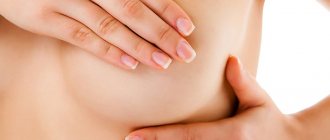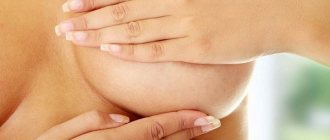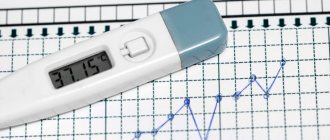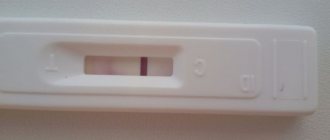Before menstruation approaches, signs of premenstrual syndrome occur. Discharge from the breast before menstruation is a symptom that requires a visit to the doctor. Only a mammologist can determine the true cause of the deviation. Sometimes a sign may be a variant of the norm. The most dangerous possible deviation is breast cancer. The disease can be asymptomatic for a long period of time. You need to pay attention to the volume and color of the discharge. A woman needs to undergo a comprehensive diagnosis. This is the only way to find out the true cause of the changes occurring in the mammary gland.
Any discharge from the chest is an alarming symptom
Types of liquid
Discharge from the breast before menstruation can be of different shades. There are transparent, yellow, green. The consistency is liquid or slimy. The following cases need to be highlighted:
- With mastitis, greenish discharge is often observed. In addition, additional symptoms appear, which manifest themselves in the form of breast enlargement and pain.
- With ductectasia, colorless discharge from the mammary glands is observed in women after 35 years of age. Doctors say that if they appear before the critical days, this is a normal physiological process.
- While carrying a baby and feeding it with milk, a yellowish liquid often appears.
- Discharge from the breasts before menstruation is often observed after accidental injury to the mammary gland. At first, yellowish water oozes out - this indicates that damaged tissue is being restored.
- With fibrocystic mastopathy, yellowish fluid comes out of the nipple and pain is felt in the chest. If liquid discharge from the mammary glands appears, you need to contact a mammologist. Because this may indicate that cancer is developing. If severe pain occurs when pressing on the nipples, then this should be a cause for concern. In this case, it is important to immediately undergo a thorough medical examination.
- If the vessels are damaged, dark discharge from the mammary gland appears. They often arise due to the development of a cancerous tumor or cystic mastopathy.
- During the development of the tumor process, bloody fluid is released from the breast. Malignant neoplasms damage blood vessels. In such conditions, timely treatment should be carried out.
- Hemorrhage is a disease that requires timely treatment. With this disease, the regularity of the menstrual cycle is disrupted. In addition, white liquid in the form of colostrum oozes.
- Dark discharge from the breast before menstruation is a sign of the development of cancer. In this case, it is important to consult a doctor and determine the nature of the tumor (benign or malignant).
Other pharmacological remedies for cracked nipples
On the domestic market, the ointment or gel Solcoseryl, recommended as a remedy for cracked nipples, as well as its synonym (generic) Actovegin cream, are quite popular.
The main active ingredient of these products is a biogenic stimulant made from calf blood serum purified from proteins (deproteinized). According to manufacturers, low-molecular hemodialysate promotes pain relief and healing of wounds, trophic ulcers and burns, stimulates the regeneration of skin and subcutaneous tissue with minimal scarring. In the official instructions there are no recommendations to use Solcoseryl for juice cracks.
Solcoseryl is banned as a drug by the FDA in the United States, as well as in Canada by the National Pharmacology Committee (NAPRA). Actovegin cream has also been banned in these countries since 2011, and in Western Europe, Australia and Japan, this product does not have official approval for use as a medicine.
In the treatment of inflamed pustular (streptococcal and staphylococcal) inflammations, they can be used as an ointment for cracked nipples:
- Sintomycin (1% syntomycin emulsion) is a bacteriostatic antibiotic of the chloramphenicol group (chloramphenicols);
- Levomekol (levomycetin methyluracil) polyethylene oxides included in this ointment, when ingested in a newborn's body in significant quantities, can cause acidosis, bloating, diarrhea, hemodynamic disturbances, and a decrease in blood pressure and body temperature.
- Methyluracil - 10% ointment based on a substance that is a non-steroidal anabolic steroid that can accelerate the restoration of damaged tissues and stimulate the synthesis of blood cells (leukocytes and erythrocytes); recommended for the treatment of radiation damage to the skin, purulent wounds, burns, trophic ulcers, bedsores, dermatitis, etc.
- For weeping cracks with dermatitis or streptoderma, the following are suitable:
- zinc ointment containing zinc oxide, which works as an antiseptic and anti-exudant; relieves inflammation and irritation, but forms crusts on the skin;
- Sudocrem (analogous to Desitin ointment) contains zinc oxide, the astringent properties of which are softened by lanolin;
- antiseptic ointment Vinilin for cracked nipples (Polivinox) with the development of purulent inflammation (mastitis) is now used very rarely, although it helps restore the epithelium; however, it should not be used without consulting a doctor.
The most common folk remedies for cracked nipples include oils, vitamins, bee products (propolis and honey), and medicinal plants.
Which oil is the most effective? This is considered to be sea buckthorn oil for cracked nipples - due to the presence of omega fatty acids (linoleic and α-linolenic), monounsaturated fatty acids (palmitic), carotenoids (β-carotene, zeaxanthin and lycopene), tocopherol (vitamin E), tocotrienols and plant sterols.
Also recommended as oil for cracked nipples are: cocoa butter, rosehip oil, eucalyptus, almond, peach, and tea tree oils.
Vitamin E, which has antioxidant properties for cracked nipples, helps protect the skin from infections and also facilitate the restoration of damaged epithelium.
Vitamin A for cracked nipples (in the form of an oil solution of Retinol acetate) enhances the skin’s ability to resist pathological keratinization. In pharmacies you can find Vitaderm ointment with an oil solution of carotene.
Good home remedies are an emulsion for lubricating cracked nipples based on fish oil (rich in vitamin A) and propolis dissolved in warm boiled water, as well as a balm consisting of natural liquid honey (preferably May honey) and fish oil (in a ratio of 3:1) .
Poorly healing cracks in the nipples are popularly treated with compresses of fresh viburnum juice, a decoction of stinging nettle, a mixture of freshly squeezed carrot juice and agave leaves (1:2). And when thrush appears on the nipples, it is recommended to wash the nipples with decoctions of burdock roots, black elderberry flowers and calendula or walnut leaves.
Properly selected cream or ointments for cracked nipples will help prevent cracked nipples and speed up their healing. Antibacterial ointments are needed for infectious inflammation. But no other moisturizers typically used on other parts of the body should be applied to the nipple area! And look carefully at what is included in this or that remedy for cracked nipples.
Natural causes of discharge
There are several other reasons why nipple discharge may appear before your period. After all, this symptom does not always indicate that a serious disease is developing. But it is still better to visit a medical professional and undergo a thorough medical examination. Thanks to this, the presence or absence of pathologies can be identified. The physiological processes of breast discharge include:
- While carrying a baby, fluid appears from the mammary glands - the body is preparing for lactation. Most often, the symptom appears in the eighth or ninth month of pregnancy. Under such conditions, the tone of the uterus often increases. The liquid has a white or yellowish tint - this process does not in any way affect the woman’s general well-being.
- Lactation after miscarriage. Colostrum can be released from the mammary glands 7-30 days after termination of pregnancy. If your health has deteriorated significantly, you should visit a doctor - this may indicate that complications have arisen.
- Treatment with birth control pills stimulates lactation. Under such conditions, you may notice yellowish discharge from the nipples before your period.
What does the appearance of colostrum before menstruation mean?
Colostrum is a secretion of the female mammary glands, which is normally produced in women several days before and after childbirth.
Cases when colostrum is formed before menstruation are rare, but this is still observed in some girls.
To understand in which cases this symptom is normal, and when it is pathological, you need to understand in more detail the causes and characteristics of breast discharge.
Sometimes there is discharge from the breasts during menstruation
What is the characteristic of breast discharge
In women, the production of colostrum indicates the readiness of the mammary glands for lactation. The secretion is formed under the influence of hormones, the level of which increases when the uterus prepares for childbirth. After the baby is born, colostrum stops being released 2–4 days later and is replaced by breast milk.
According to statistics, 15% of women secrete colostrum before menstruation. Also, fluid from the nipples may appear during menstruation and during ovulation.
In most cases, deviation from the norm is observed due to hormonal imbalance.
Note! The presence of pathology may be indicated by the color of colostrum, which can be transparent, white, or yellow. Discharge mixed with blood is dangerous.
Experts recommend that women who are faced with a problem such as the appearance of colostrum after, before or during menstruation, contact a gynecologist to determine the causes.
If you experience such symptoms, you should definitely consult your doctor.
Can colostrum before menstruation indicate pregnancy?
The onset of lactation, which is indicated by the formation of colostrum, is itself an indicator of pregnancy. In most cases, the physiological preparation of the mammary glands for breastfeeding begins immediately before childbirth. However, the occurrence of colostrum in the early stages of pregnancy cannot be ruled out.
Symptoms of the premenstrual period do not exclude the possibility of fertilization. After conception, a woman begins to have a hormonal imbalance, and, as a rule, the level of hormones responsible for the normal course of pregnancy and the process of childbirth increases sharply, which leads to breast enlargement, increased sensitivity of the nipples and the release of fluid from them.
Gynecologists do not deny that colostrum before menstruation is a sign of pregnancy. Even if menstruation has occurred, fertilization is not excluded, since conception could have occurred immediately before the onset of regulation, or the body has not yet had time to rebuild.
What other reasons for the appearance of colostrum
A number of factors can provoke the formation of colostrum before menstruation, which can be attributed to external causes that have a negative impact and cause a pathological condition of the mammary glands.
The release of colostrum is possible after taking hormones
Possible reasons for the appearance of colostrum:
- injury to the mammary glands, leading to disruption of the supply of nerve impulses that stimulate preparation for lactation;
- the use of hormonal drugs, including oral contraceptives, that affect the level of female hormones;
- an increase in the level of prolactin, the hormone responsible for the production of breast milk;
- spontaneous or medical abortion, leading to a serious hormonal imbalance.
It should be noted that women who have given birth to a child and are feeding them with their own milk may continue to experience fluid from the nipples during the premenstrual period and during menstruation for a year after cessation of lactation.
What diseases may this disorder indicate?
The production of colostrum in the absence of pregnancy can be a symptom signaling the development of diseases that pose a risk to a woman’s life.
False lactation can occur with the progression of the following pathologies:
- benign tumor formations (adenomas, fibroadenomas, breast papillomas, cysts or carcinomas);
- a malignant type of tumor in the female breast;
- mastopathy (proliferation of internal tissues of the gland);
- thyroid diseases;
- brain tumors;
- liver diseases.
In some cases, the cause may be a diseased liver
Dysfunction of organs such as the liver, thyroid gland and brain would seem to be unrelated to female breasts, but they are all responsible for the level of hormones, so if their work malfunctions, pathological discharge from the nipples may be observed during menstruation and at other times.
Important! One of the symptoms of breast cancer is the discharge from the female nipples of a fluid resembling colostrum mixed with blood or pus.
How is diagnostics carried out?
An examination when colostrum appears during menstruation begins with a visit to a female gynecologist. The specialist conducts a detailed interview with the patient, and then examines her. When examining a woman’s breasts, attention must be paid to the density of the mammary glands, the presence of lumps, the presence of pain and the characteristics of the discharge itself.
The gynecologist may prescribe laboratory tests of a smear, as well as blood. A blood test involves determining several indicators:
- Total information;
- hormone levels;
- glucose level;
- condition of blood cells.
A blood test is required to find the cause of the pathology.
After determining a preliminary diagnosis, it is recommended to perform hardware diagnostics, including:
- Ultrasound of the mammary glands (if necessary, other organs);
- mammography with contrast agent.
Among laboratory blood tests, there is always an analysis for the level of hCG, which determines whether a woman is pregnant.
What symptoms require you to see a doctor?
The main reason for the production of colostrum in women during the premenstrual period or during menstruation is considered to be hormonal imbalance, which in itself is not considered a dangerous pathology and is observed in most girls.
If the discharge was a one-time occurrence and stopped after the end of your period, you don’t have to worry about pathological causes, but a consultation with a doctor will not be superfluous. However, if, in addition to the appearance of fluid from the nipples, other symptoms are bothering you, you cannot postpone a visit to the gynecologist.
If you want to know the causes of nipple discharge, watch this video:
A visit to the doctor is necessary immediately if:
- the secreted secretion has a greenish, grayish or brown tint;
- there is blood in the liquid;
- nipples and skin are hyperemic;
- the chest is “filled up”;
- soreness and unnatural sensitivity appeared;
- general condition worsened.
These symptoms indicate an unambiguous development of the disease. Colostrum during menstruation can be a physiological manifestation, but to exclude dangerous diseases, it is advisable to visit a doctor and do a preventive examination. It should be remembered that breast cancer is considered one of the common pathologies of the female body.
Source: https://mesyachnie.com/informacija/molozivo.html
Common diseases
As medical practice shows, there are several main diseases that provoke the appearance of fluid from the mammary glands. These include:
- Ductectasia. With this disease, the glands become clogged, which causes the development of a severe inflammatory process. In some cases, the disease occurs in women over 35 years of age.
- Mastopathy is a benign change in the mammary glands. With this disease, white discharge appears from the breasts before or after menstruation. Also, as the disease develops, a greenish liquid often appears. This indicates that harmful microorganisms multiply in the mammary glands, which provoke an inflammatory process and suppuration. If a clear, odorless liquid oozes, this is a symptom of galactorrhea, which is often caused by an excess of the hormone prolactin.
- Mastitis is a disease most often found in women after childbirth. During the development of the disease, a strong inflammatory process occurs. Under such conditions, the patient experiences pain in the mammary glands and discomfort during lactation.
- Cancer is a malignant neoplasm that occurs due to uncontrolled cell division.
- Intraductal papilloma - with this disease, blood is present in the fluid from the mammary glands.
There are many factors under the influence of which discharge from the stomach may suddenly appear. Only a doctor can identify the main cause of their occurrence after a thorough examination of the patient.
What is considered normal
It is normal for colostrum to be released a week before your period during conception. Also, after completing breastfeeding, it is possible to observe periodic or constant appearance of secretions for 2 years.
There are several other cases in which the appearance of colostrum is considered normal:
- Strong sexual arousal. It provokes a large amount of blood flow, which stimulates the work of the alveoli, which are responsible for milk production.
- Nipple stimulation. It also stimulates libido and the filling of the mammary glands with blood. A signal is sent to the brain about the development of sucking processes and the need to secrete milk to feed the baby. But since during the period when a woman has not given birth, a rather small amount of the hormone prolactin is released, it is only enough for a couple of drops of colostrum. However, there are cases where a nulliparous woman, with constant breastfeeding of her baby, began full lactation.
- Thermal effects on the chest. It also stimulates blood flow to the breast tissue. This can happen after a sauna, steam bath, heavy physical activity, sunbathing, etc.
What factors provoke the development of diseases?
- If colostrum is released from the breast in the early stages of pregnancy, this may indicate that a chronic disease that was identified before the baby was conceived has worsened.
- During the development of disease of the thyroid gland and pituitary gland, discharge from the breast appears before menstruation, as these organs regulate and stabilize hormonal levels.
- Discharge from the chest also occurs due to an unhealthy lifestyle. Smoking and alcohol abuse often cause problems with the reproductive system.
- Systematic fatigue and long-term treatment with medications.
- Colds.
Signs of a tumor
When a malignant neoplasm appears in women, the following symptoms occur:
- the presence of blood in the fluid that is released from the chest;
- severe pain in the mammary glands;
- The shape of the breast and the color of the nipples change.
Many people are interested in whether brown discharge from the mammary glands before menstruation is normal or not? Most likely, this is a sign of a tumor disease.
Diagnostics and medical consultation
Hardware diagnostics of breast condition is carried out through:
- Ultrasound.
- Mammography.
- Mammography with contrast (if papilloma is suspected).
From laboratory testing the following are prescribed:
- Blood test (prolactin level is determined).
- Cytological examination of a sample of discharge.
Self-examination
Breast self-examination allows you to detect abnormalities at an early stage. Self-inspection techniques can be easily learned by simply following these steps. Inspect the laundry for foreign traces. Pay attention to the nipples and areola (rash, peeling, redness). Expose your breasts in front of the mirror, raise your arms, and inspect the skin and nipple shape. In a lying position, feel the area of the mammary gland with your fingers: palpate the breast in a circular motion for the presence of lumps. Such palpation should be regular according to the same pattern.
Cytology of discharge
Cytological examination determines the exact number of cancer cells in the fluid secreted by the mammary glands. The diagnosis is confirmed by accompanying techniques. A puncture of the skin of the areola is performed if Paget's cancer is suspected. A biopsy of the nipple epidermis is an accurate diagnostic procedure that allows you to determine the number of tumor cells. It involves taking a piece of tissue to study under a microscope and differentiate the nature and type of neoplasm.
Causes of the disease
For what reasons can an illness occur? Fibroadenoma and cancerous tumors most often develop as a result of smoking and alcohol abuse. An unbalanced diet, lack of sleep, and systematic fatigue can cause the development of many ailments. Many people ignore the need to cleanse the body of helminths, fungi and toxins.
As medical practice shows, cancer is most often diagnosed in women with a hereditary predisposition to the disease. If strange discharge from the mammary glands appears, there is no need to self-medicate. You should visit a mammologist - the doctor will prescribe an individual treatment regimen.
The essence of treatment
There is discharge from the mammary glands before menstruation - what to do? It is impossible to carry out therapy at home; it is necessary to undergo a thorough medical examination in order for the doctor to identify the factor that provoked the development of the pathological condition. Depending on the identified disease, the doctor will prescribe suitable therapy. Taking into account the severity of the disease, the individual and physiological characteristics of the patient’s body, the specialist will recommend effective medications.
If before menstruation the mammary glands hurt and the discharge causes discomfort due to hormonal imbalance, then therapy is carried out with the help of Bromocriptine. The dosage of the medication is 2-4 mg per day. The dose is determined strictly by the treating specialist. Thanks to treatment with pills, hormonal levels can be stabilized. It is recommended to use folk remedies only after consulting a doctor.
Is treatment necessary for nipple discharge?
If before menstruation a woman notices discharge of an unnatural color, under no circumstances should she self-medicate, including the following:
- Apply a heating pad and warm your breasts in other ways.
- Trying to squeeze out the liquid by mechanical action provokes even more production.
- Take any hormone-containing medications, including contraceptives, at your discretion.
- Delay your visit to the mammologist.
Only a specialist can determine the real cause of the discharge and prescribe the correct treatment.
The main therapeutic measures are aimed at restoring performance:
- Ovaries.
- Liver.
- Thyroid gland.
The basis of therapy are medications containing the hormone progesterone or estrogen. In addition to hormonal drugs, other medications are prescribed, the specificity of which depends on the disease present, the age of the patient and other clinical factors. Mainly prescribed:
- Antibiotics.
- Analgesics.
- Vitamins.
- Drugs that slow down milk production.
- Means for restoring water and electrolyte balance.
If drug therapy fails to get rid of the tumor, specialists decide on surgical treatment (partial or complete removal of the mammary gland).
After the operation the following is prescribed:
- Hormonal therapy.
- Chemical and radiation therapy.
- Vitamin therapy.
How to prevent the development of diseases?
To prevent nipple discharge, you must follow the advice of your doctor to help maintain breast health. These include:
- Don’t be nervous about little things, avoid stressful situations. Nervous stress is a common cause of hormonal imbalance. Under such conditions, many women's diseases develop.
- You should eat right and lead a healthy lifestyle - do not abuse alcohol, and get plenty of rest. Thanks to such recommendations, you can increase the protective function of the human body.
- Obesity can cause changes in the mammary gland, so it is important to control your weight.
- It is not recommended to take contraceptives for a long time. The drug must be selected strictly according to the recommendation of the attending physician. If pain occurs in the mammary gland, it is necessary to undergo a thorough medical examination.
Women over 49 years of age need to visit a mammologist every 6 months.
How to use cream for cracked nipples
Before you start using the medicinal cream, you should very carefully read the instructions included with the drug.
If a woman has a tendency to exhibit an allergic reaction, it is first necessary to conduct a test to determine the sensitivity of the skin to the components of the medicine. To do this, apply a small amount of the drug to the inside of the elbow joint or wrist and observe the condition of the treated area for twenty minutes.
The method of application and dose are purely individual. They are described in detail in the instructions attached to any pharmacological agent.
The method of using such creams is simple. It is used several times throughout the day. In general, the nipple should be lubricated with medicated cream immediately after feeding. And be sure to rinse with warm water before the next feeding procedure, although such compositions are quickly absorbed into the skin, it still wouldn’t hurt to be on the safe side. And according to the recommendation of pediatricians, breasts should be rinsed before each feeding.
The duration of use of these creams is determined depending on the severity of the damage and the effectiveness of wound relief.
Creams of this pharmacological group are not addictive and do not accumulate in the body, which is why their long-term use is allowed.
Reviews from women
Many women have experienced discharge from the breasts before menstruation - patient reviews confirm this fact. We can conclude that this sign indicates that prolactin is elevated. Many patients were diagnosed with euthyroidism, since thyroid diseases affect a woman’s hormonal levels. Thanks to Mastodinon and Eutirox, it is possible to eliminate an unpleasant sign of a pathological condition.
Normalizes the functioning of the gland and the Alba dietary supplement. Most often, colostrum is released from the breast when prolactin is elevated; less often, it indicates successful conception. According to the girls, it is necessary to visit a mammologist, since the development of an unpleasant symptom may indicate that a strong inflammatory process has occurred or a malignant tumor is developing.
Note to the patient
If fluid is released from the breast before menstruation, then you need to visit a mammologist. It’s better not to risk your health and play it safe. In some cases, the appearance of such a symptom indicates that cancer is developing. To maintain the functioning of the reproductive system, women are recommended to undergo regular medical examinations. During the development of many diseases, discharge from the mammary glands appears. Thanks to ultrasound diagnostics and other types of studies, it is possible to identify the presence or absence of pathologies.
Ointments for cracked nipples with vitamin B5
Panthenol ointment (other trade names - Bepanten, Pantoderm) is recognized as an effective remedy for cracked nipples thanks to the vitamin B5 derivative dexpanthenol (pantothenic acid) included in it. This vitamin is involved in tissue regeneration processes in the body and, absorbed into the skin when applied externally, normalizes intracellular metabolism, stimulating the restoration of damaged nipple tissue.
The ointment also contains medical Vaseline (a mixture of refined petroleum paraffins), which retains moisture well in the skin, preventing it from cracking. The official instructions for Panthenol ointment indicate that before feeding the baby, the nipple must be freed of ointment residues using a napkin and boiled water.
Obviously, this is due to two factors. Firstly, you should avoid getting Vaseline on the mucous membranes. Secondly, pantothenic acid that enters the child’s body during feeding can increase the production of acetylcholine, which may result in increased diuresis, sleep problems, abdominal pain and bloating, constipation or diarrhea.
Contains 5% dexpanthenol and cream for cracked nipples MamaCare (Ukraine); In addition, it contains sea buckthorn and calendula oils, vitamin E and polyunsaturated fatty acids - linoleic and linolenic.









